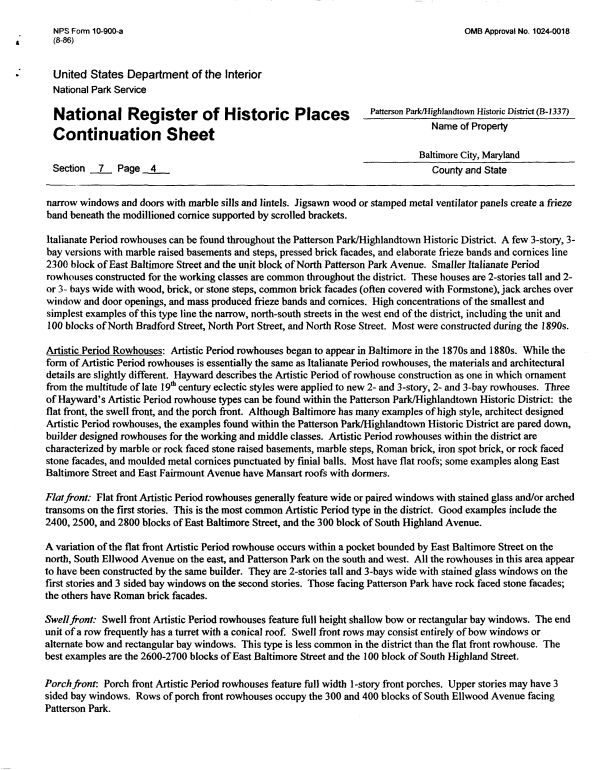 |
||||
|
DEPARTMENT OF HOUSING AND COMMUNITY DEVELOPMENT, MARYLAND HISTORICAL TRUST (Historic Sites Survey) var.d. MSA SE16-3 Image No: se16-3-0089 Enlarge and print image (93K) |
 |
||||
|
DEPARTMENT OF HOUSING AND COMMUNITY DEVELOPMENT, MARYLAND HISTORICAL TRUST (Historic Sites Survey) var.d. MSA SE16-3 Image No: se16-3-0089 Enlarge and print image (93K) |
| NPS Form 1 0-900-a OMB Approval No. 1 024-001 8 (8-86) United States Department of the Interior National Park Service Patterson National Register of Historic Places <* A. x. *%•_ A Name of Property Continuation Sheet Baltimore City, Maryland Section 7 Page 4 County and State narrow windows and doors with marble sills and lintels. Jigsawn wood or stamped metal ventilator panels create a frieze band beneath the modillioned cornice supported by scrolled brackets. Halianate Period rowhouses can be found throughout the Patterson Park/Highlandtown Historic District. A few 3-story, 3-bay versions with marble raised basements and steps, pressed brick facades, and elaborate frieze bands and cornices line 2300 block of East Baltimore Street and the unit block of North Patterson Park Avenue. Smaller Italianate Period rowhouses constructed for the working classes are common throughout the district. These houses are 2-stories tall and 2-or 3- bays wide with wood, brick, or stone steps, common brick facades (often covered with Formstone), jack arches over window and door openings, and mass produced frieze bands and cornices. High concentrations of the smallest and simplest examples of this type line the narrow, north-south streets in the west end of the district, including the unit and 100 blocks of North Bradford Street, North Port Street, and North Rose Street. Most were constructed during the 1890s. Artistic Period Rowhouses: Artistic Period rowhouses began to appear in Baltimore in the 1870s and 1880s. While the form of Artistic Period rowhouses is essentially the same as Italianate Period rowhouses, the materials and architectural details are slightly different. Hayward describes the Artistic Period of rowhouse construction as one in which ornament from the multitude of late 19* century eclectic styles were applied to new 2- and 3-story, 2- and 3-bay rowhouses. Three of Hayward's Artistic Period rowhouse types can be found within the Patterson Park/Highlandtown Historic District: the flat front, the swell front, and the porch front. Although Baltimore has many examples of high style, architect designed Artistic Period rowhouses, the examples found within the Patterson Park/Highlandtown Historic District are pared down, builder designed rowhouses for the working and middle classes. Artistic Period rowhouses within the district are characterized by marble or rock faced stone raised basements, marble steps, Roman brick, iron spot brick, or rock faced stone facades, and moulded metal cornices punctuated by finial balls. Most have flat roofs; some examples along East Baltimore Street and East Fairmount Avenue have Mansart roofs with dormers. Flat front: Flat front Artistic Period rowhouses generally feature wide or paired windows with stained glass and/or arched transoms on the first stories. This is the most common Artistic Period type in the district. Good examples include the 2400,2500, and 2800 blocks of East Baltimore Street, and the 300 block of South Highland Avenue. A variation of the flat front Artistic Period rowhouse occurs within a pocket bounded by East Baltimore Street on the north, South Ellwood Avenue on the east, and Patterson Park on the south and west. All the rowhouses in this area appear to have been constructed by the same builder. They are 2-stories tall and 3-bays wide with stained glass windows on the first stories and 3 sided bay windows on the second stories. Those facing Patterson Park have rock faced stone facades; the others have Roman brick facades. Swell front: Swell front Artistic Period rowhouses feature full height shallow bow or rectangular bay windows. The end unit of a row frequently has a turret with a conical roof. Swell front rows may consist entirely of bow windows or alternate bow and rectangular bay windows. This type is less common in the district than the flat front rowhouse. The best examples are the 2600-2700 blocks of East Baltimore Street and the 100 block of South Highland Street. Porch front: Porch front Artistic Period rowhouses feature full width 1-story front porches. Upper stories may have 3 sided bay windows. Rows of porch front rowhouses occupy the 300 and 400 blocks of South Ellwood Avenue facing Patterson Park. |